A group of artists was formed in the early 20th century that transformed the world of art indefinitely.
The Fauvists or “Wild Beasts” produced some of the most colorful paintings in history. The foundation was laid by the Impressionists and Post-Impressionists in the late 19th century.
The main difference is that they didn’t care about accurately depicting what they saw. This resulted in peculiar landscapes and figures.
The Fauvism movement started around 1904 and only lasted until 1910. Three exhibitions were held during this period and the leaders of the Fauvism movement were Henri Matisse (1869-1954) and André Derain (1880-1954).
Although this art movement was short-lived, it influenced various other subsequent modern art movements. Several Fauves became Cubist artists who produced amazing Cubist paintings during the 1910s and 1920.
In this article, you’ll discover some of the most famous Fauvism paintings.
1. Le Bonheur de Vivre – Henri Matisse
- Date created: 1905-1906
- Dimensions: 176.5 × 240.7 centimeters (69.5 × 94.75 inches)
- Location: Barnes Foundation, Philadelphia, United States
Le Bonheur de Vivre is one of the ultimate masterpieces of Henri Matisse, one of the leading figures of the Fauvism art movement. Despite the initial criticism that this remarkable painting received when it was first exhibited, it’s considered to be one of the most important paintings of the early 20th century today.
The painting was exhibited at the Salon des Indépendants in 1906 and depicts a landscape that drowns in bright colors. Naked women, people playing music and dancing, and people having a good time make up the composition. The group dancing in the central part was reused by Matisse in his famous work called “The Dance” (1909-1910).
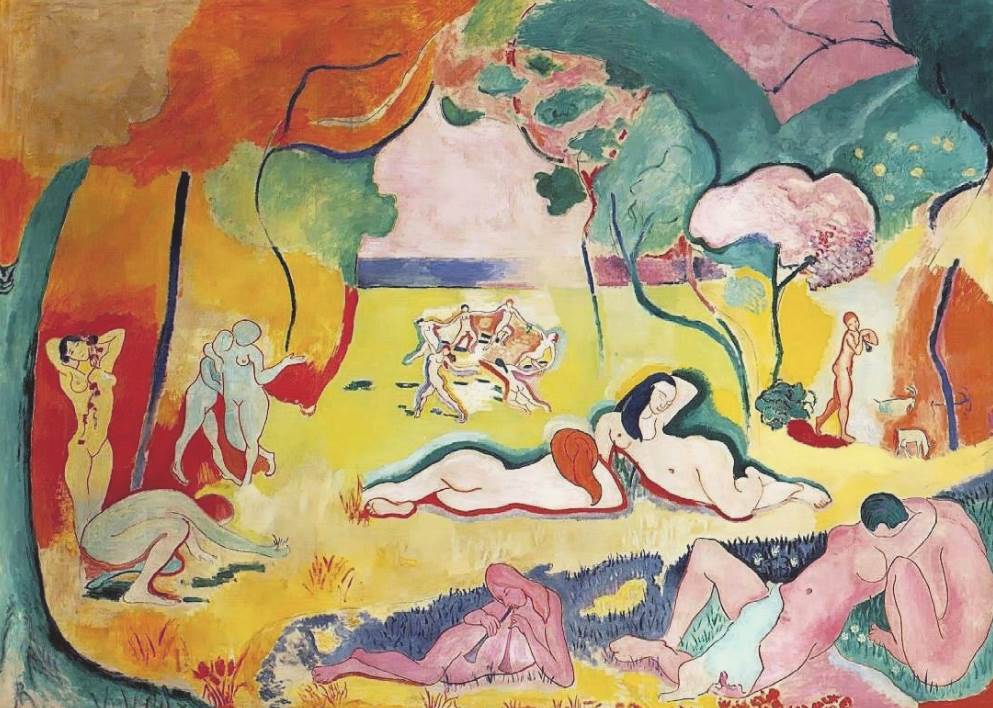
2. Charing Cross Bridge – André Derain
- Date created: 1906
- Dimensions: 81 x 100 centimeters (31.88 x 39.37 inches)
- Location: Musée d’Orsay, Paris, France
Charing Cross Bridge is a painting by French artist André Derain which he produced while he visited London in the early 20th century. It’s one of the approximately 30 paintings that he produced during his two visits to the city.
This painting by Derain is considered to be one of the greatest examples of what the Fauvism art movement was about. Bright colors that aren’t derived from reality. The buildings are blue, the trees, red, and the sky yellow, making it one of the most remarkable paintings of London ever produced.
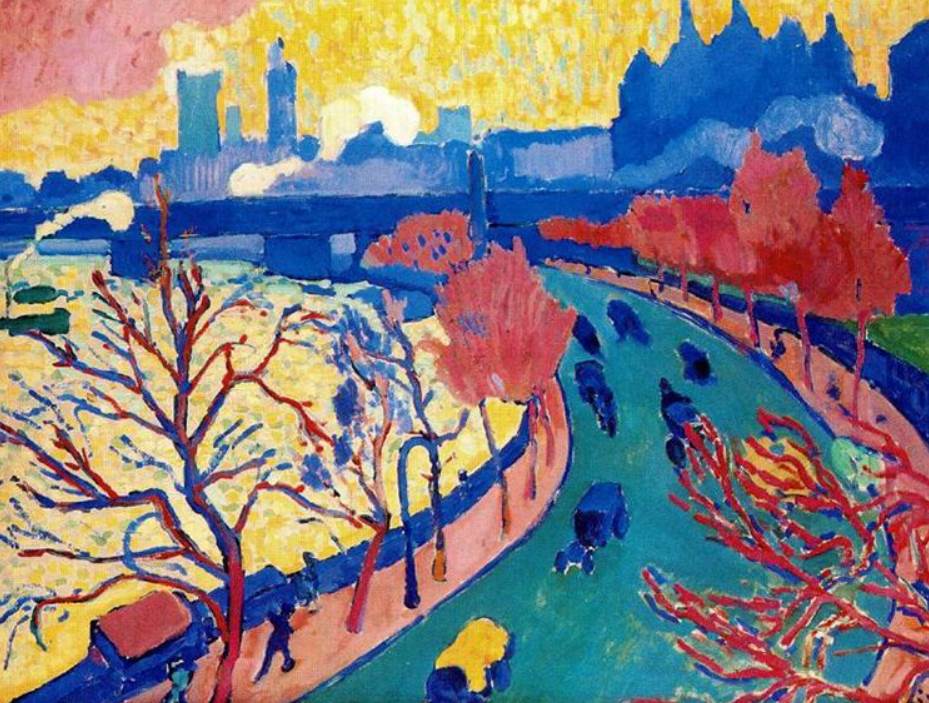
3. Colored Landscape with Aquatic Birds – Jean Metzinger
- Date created: 1907
- Dimensions: 75.5 × 101 centimeters (29.7 × 39.8 inches)
- Location: Musée d’Art Moderne de la Ville de Paris (MAM), Paris, France
Colored Landscape with Aquatic Birds or “Paysage coloré aux Oiseaux Aquatiques” is a painting that was highly influential for the Cubist art movement. French painter and color theorist Jean Metzinger (1883-1956) used colors produced by the Fauves to paint a tropical landscape.
The painting by Metzinger is defined as a “Proto-Cubist” painting in which the artist paid homage to several artists that came before him. Some of these include Paul Gauguin (1848-1903), Paul Cézanne (1839-1906), and Henri Rousseau (1844-1910). The latter was a close friend of Metzinger who produced several paintings of tropical landscapes.

4. The River Seine at Chatou – Maurice De Vlaminck
- Date created: 1906
- Dimensions: 81.6 × 101 centimeters (32.12 × 39.25 inches)
- Location: MET Museum, New York City, United States
The River Seine at Chatou is a painting by Maurice De Vlaminck, another artist who was one of the leading figures of the Fauvism art movement. The River Seine at Chatou is his best-known work from this period and is currently on display at the Metropolitan Museum of Art in New York City.
The painting depicts his hometown of Chatou where he moved at the age of 16. This town is located just west of Paris and although it was a quiet rural town outside of the big city at the time, it’s practically a suburb of Paris today. Together with Derain, the artist started the “School of Chatou” here which focused on the use of bright colors.
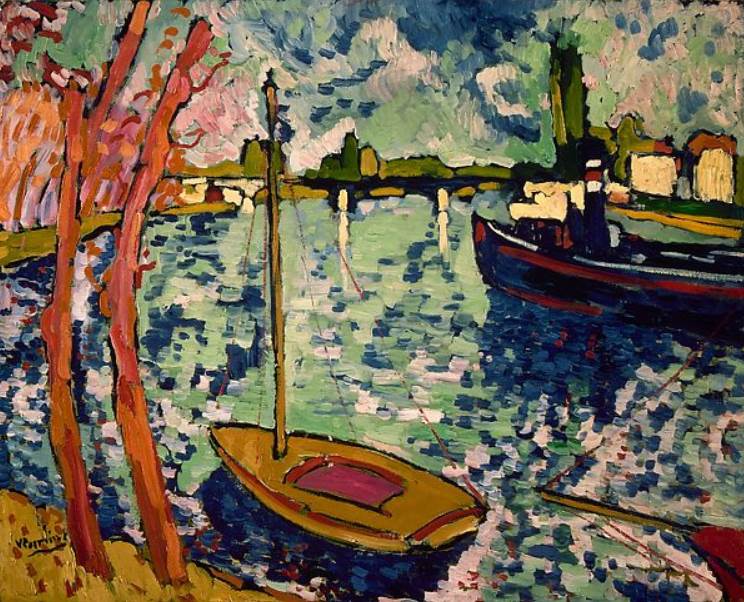
5. Landscape near Antwerp – Georges Braque
- Date created: 1906
- Dimensions: 60 x 81 centimeters (23.62 x 31.87 inches)
- Location: Solomon R. Guggenheim Museum, New York City, United States
Landscape near Antwerp is a painting by Georges Braque that he produced after an unsuccessful exhibition at the Salon des Indépendants in Paris in March 1906. He exhibited 7 paintings there and destroyed all of them shortly after. After all, this was where “Le Bonheur de Vivre” and other famous Fauvism paintings were displayed as well.
He traveled to the Belgian city of Antwerp during the summer of 1906 and radically changed his style by using extremely bright colors. The landscape near Antwerp is one of the best examples of the artistic switch that Braque made that year.
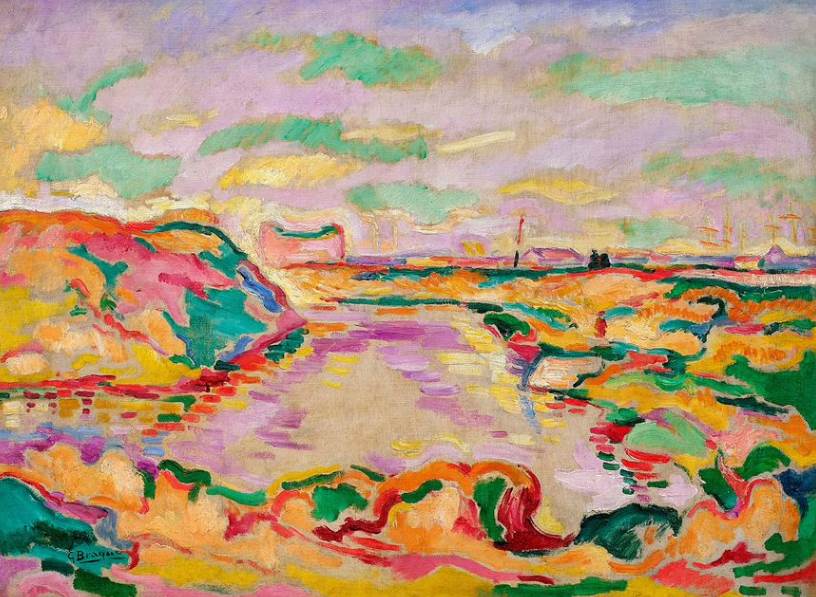
6. The Green Stripe – Henri Matisse
- Date created: 1905
- Dimensions: 40.5 × 32.5 centimeters (15.9 × 12.8 inches)
- Location: National Gallery of Denmark, Copenhagen, Denmark
The Green Stripe is also known as “The Portrait of Madame Matisse” or “The Green Line.” It depicts the wife of the leader of the Fauvism art movement Henri Matisse, a woman named Amélie Noellie Matisse-Parayre.
The name of the painting is a reference to the green stripe that divides the face of the depicted woman. This particular feature came as a shock to the people who saw the painting for the first time, including the close friends of the artist. Regardless, it remains one of the most striking Fauvism paintings ever produced.
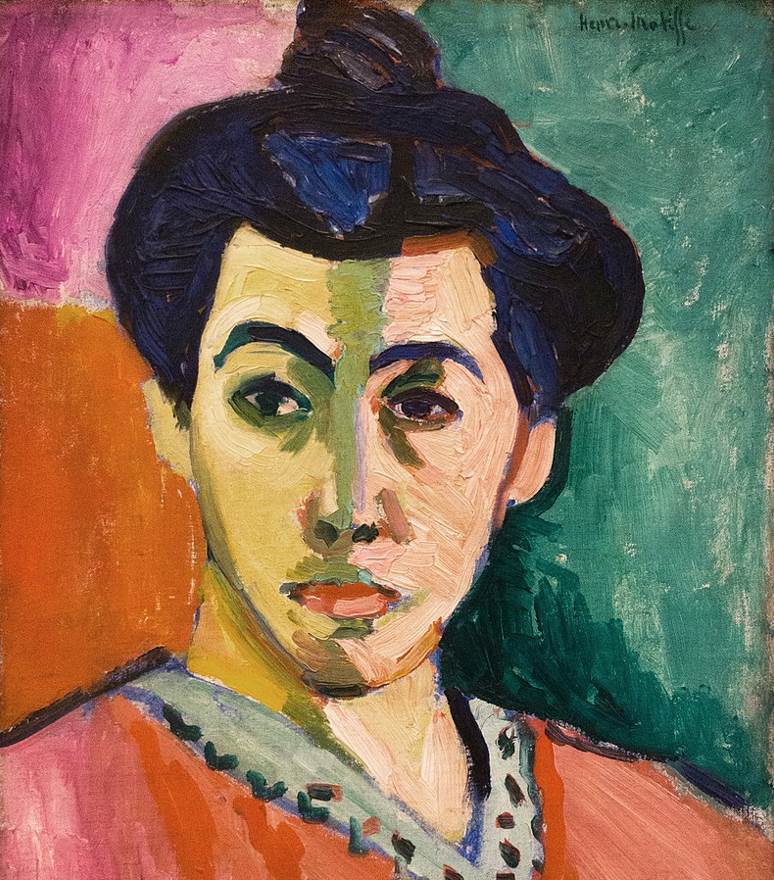
7. Boats at Martigues – Raoul Dufy
- Date created: 1908
- Dimensions: 65 x 54 centimeters (25.59 x 21.25 centimeters)
- Location: Courtauld Institute of Art, London, United Kingdom
Boars at Martigues can be described as the epitome of Raoul Dufy’s Fauve period. It was completed in 1907 and depicts boats embarked on the seaside in the Côte d’Azur in the southern part of France.
This extremely colorful work of art is part of a series of 6 paintings that depict a similar scene in Martigues. The spatial arrangement of the elements was influenced by Paul Cézanne and it’s clear that Dufy already experimented with the Cubist ideas that made him famous later on.
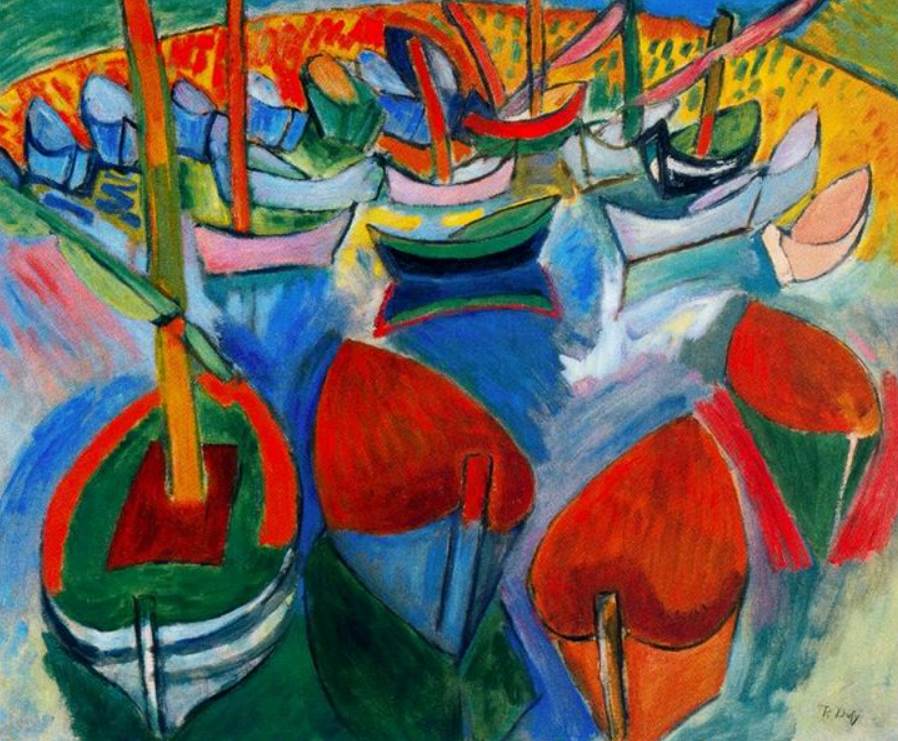
8. Port of La Ciotat – Georges Braque
- Date created: 1907
- Dimensions: 64.8 x 81 centimeters (25.5 x 31.87 inches)
- Location: National Gallery of Art, Washington D.C., United States
George Braque was born and raised in the port city of Le Havre in the Normandy region of France. He produced several paintings while visiting the southern part of France, and especially his paintings of 1906 and 1907 are remarkable works of art.
He was heavily influenced by the Fauvist artist during this period and the paintings depicting this port clearly emphasize this notion. He, later on, went on to become one of the leading figures of the Cubist art movement and closely worked together with Pablo Picasso (1881-1973) in the years after he completed this work.
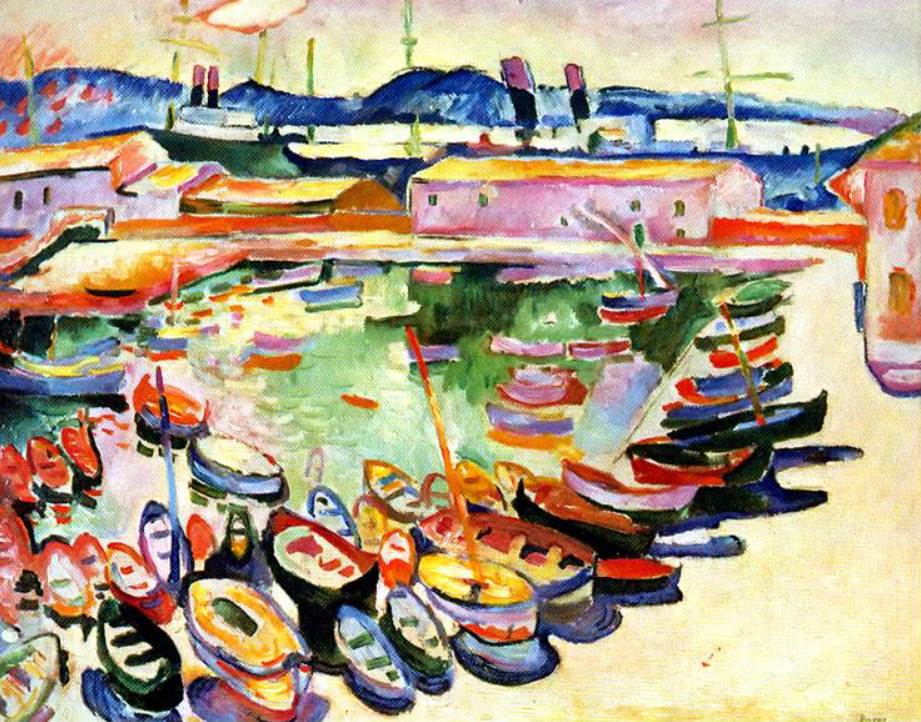
9. The Turning Road, L´Estaque – André Derain
- Date created: 1906
- Dimensions: 129.5 × 194.9 centimeters (51 x 76.25 inches)
- Location: The Museum of Fine Arts, Houston, United States
The Turning Road, L´Estaque is another masterpiece of the Fauvism art movement by André Derain. The use of colors in which trees take on shades of red, green, and blue, are defining characteristics of the artists who referred to themselves as Wild Beasts.
This painting depicts the French village of L’Estaque which is located just west of Marseille on the Côte d’Azur. It’s here that Paul Cézanne also produced several of his famous paintings. This particular work is not only one of the most important but also one of the most beautiful Fauvism paintings ever created.
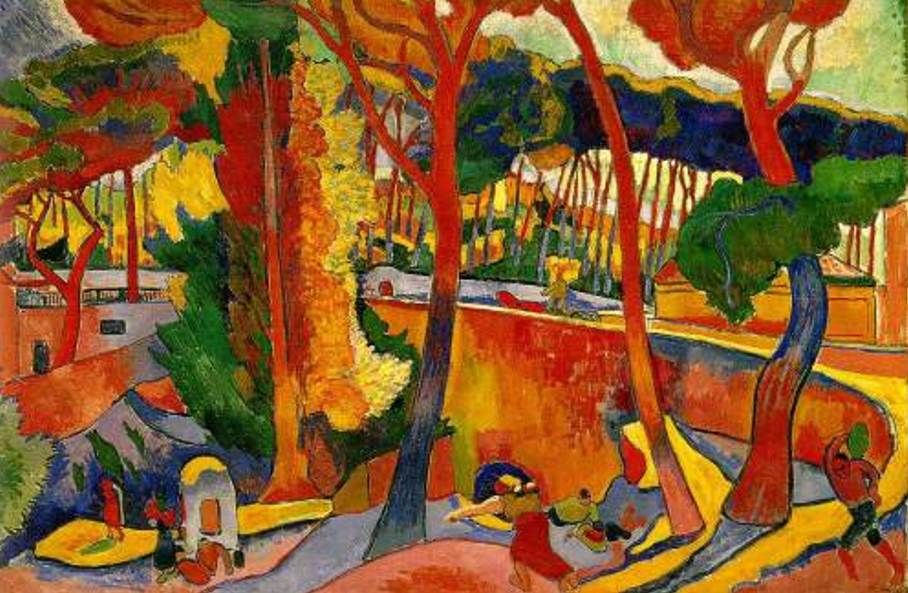
10. The Open Window – Henri Matisse
- Date created: 1905
- Dimensions: 55.3 x 46 centimeters (21.25 x 18.12 inches)
- Location: National Gallery of Art, Washington D.C., United States
The Open Window or “Open Window, Collioure” is a relatively small, yet pivotal artwork in the development of modern art. It’s one of the first paintings in which Matisse developed his new colorful style that would define the Fauves in the following years.
This painting depicts a view outside of a window in the town of Collioure on the French Mediterranean coast. Matisse had traveled here with his colleague André Derain and he produced this remarkable view outside of his hotel bedroom window during this vacation.



